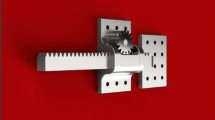Abstract
Purpose
Patients with Apert and Crouzon syndromes and craniofrontonasal dysplasia need a vault expansion within the first year of life to treat or prevent the development of raised intracranial pressure. Many craniofacial units perform a conventional posterior vault expansion as initial surgery; an alternative to this technique is the spring-assisted posterior vault expansion. The purpose of this study was to demonstrate the efficacy of spring-assisted posterior vault expansion and to compare this technique with the conventional method.
Methods
A retrospective study was conducted among all consecutive patients who received a posterior vault expansion between 2006 and 2011. Patients treated with springs were compared with patients treated with the conventional technique for blood loss, duration of surgery, postoperative hospital admittance, increase in skull circumference and anterior-posterior length, and complications.
Results
Of the 31 included patients, 15 were treated with springs, and 16, with the conventional technique. Patients treated with springs had a significantly larger increase in skull circumference and anterior-posterior length, and not significant changes in blood loss compared with the conventional group. Complications in the conventional group were the following: minor dural tear in three patients, problematic wound healing in one patient, and insufficient expansion in one patient. Spring-related complications included skin perforation in two patients, a minor dural tear in two patients, and leakage of cerebrospinal fluid after an unnoticed dural tear during spring placement in one patient.
Conclusion
Spring-assisted posterior vault expansion has some advantages over the conventional technique and is, therefore, the preferred technique in our center.




Similar content being viewed by others
References
Anderson PJ, Harkness WJ, Taylor W, Jones BM, Hayward RD (1997) Anomalous venous drainage in a case of non-syndromic craniosynostosis. Childs Nerv Syst 13(2):97–100
Arnaud E, Marchac A, Jeblaoui Y, Renier D, Di Rocco F (2012) Spring-assisted posterior skull expansion without osteotomies. Childs Nerv Syst 28(9):1545–1549
Davis C, Lauritzen CG (2009) Frontobasal suture distraction corrects hypotelorism in metopic synostosis. J Craniofac Surg 20(1):121–124
Davis C, MacFarlane MR, Wickremesekera A (2010) Occipital expansion without osteotomies in Apert syndrome. Childs Nerv Syst 26(11):1543–1548
de Jong T, Bannink N, Bredero-Boelhouwer HH, van Veelen ML, Bartels MC, Hoeve LJ, Hoogeboom AJ, Wolvius EB, Lequin MH, van der Meulen JJ, van Adrichem LN, Vaandrager JM, Ongkosuwito EM, Joosten KF, Mathijssen IM (2010) Long-term functional outcome in 167 patients with syndromic craniosynostosis; defining a syndrome-specific risk profile. J Plast Reconstr Aesthet Surg 63(10):1635–1641
de Jong T, Rijken BF, Lequin MH, van Veelen ML, Mathijssen IM (2012) Brain and ventricular volume in patients with syndromic and complex craniosynostosis. Childs Nerv Syst 28(1):137–140
Lauritzen C, Sugawara Y, Kocabalkan O, Olsson R (1998) Spring mediated dynamic craniofacial reshaping. Case report. Scand J Plast Reconstr Surg Hand Surg 32(3):331–338
Lauritzen CG, Davis C, Ivarsson A, Sanger C, Hewitt TD (2008) The evolving role of springs in craniofacial surgery: the first 100 clinical cases. Plast Reconstr Surg 121(2):545–554
Lee JA, Park DH, Yoon SH, Chung J (2008) Distractor breakage in cranial distraction osteogenesis for children with craniosynostosis. Pediatr Neurosurg 44(3):216–220
Marucci DD, Dunaway DJ, Jones BM, Hayward RD (2008) Raised intracranial pressure in Apert syndrome. Plast Reconstr Surg 122(4):1162–1168, discussion 1169-1170
Nowinski D, Di Rocco F, Renier D, Sainterose C, Leikola J, Arnaud E (2012) Posterior cranial vault expansion in the treatment of craniosynostosis. Comparison of current techniques. Childs Nerv Syst 28(9):1537–1544
Nowinski D, Saiepour D, Leikola J, Messo E, Nilsson P, Enblad P (2011) Posterior cranial vault expansion performed with rapid distraction and time-reduced consolidation in infants with syndromic craniosynostosis. Childs Nerv Syst 27(11):1999–2003
Pyle J, Glazier S, Couture D, Sanger C, Gordon S, David L (2009) Spring-assisted surgery-a surgeon’s manual for the manufacture and utilization of springs in craniofacial surgery. J Craniofac Surg 20(6):1962–1968
Riley AA, Arakawa Y, Worley S, Duncan BW, Fukamachi K (2010) Circulating blood volumes: a review of measurement techniques and a meta-analysis in children. ASAIO J 56(3):260–264
Rutland P, Pulleyn LJ, Reardon W, Baraitser M, Hayward R, Jones B, Malcolm S, Winter RM, Oldridge M, Slaney SF et al (1995) Identical mutations in the FGFR2 gene cause both Pfeiffer and Crouzon syndrome phenotypes. Nat Genet 9(2):173–176
Serlo WS, Ylikontiola LP, Lahdesluoma N, Lappalainen OP, Korpi J, Verkasalo J, Sandor GK (2011) Posterior cranial vault distraction osteogenesis in craniosynostosis: estimated increases in intracranial volume. Childs Nerv Syst 27(4):627–633
Sgouros S, Goldin JH, Hockley AD, Wake MJ (1996) Posterior skull surgery in craniosynostosis. Childs Nerv Syst 12(11):727–733
Steinbacher DM, Skirpan J, Puchala J, Bartlett SP (2011) Expansion of the posterior cranial vault using distraction osteogenesis. Plast Reconstr Surg 127(2):792–801
Swennen G, Schliephake H, Dempf R, Schierle H, Malevez C (2001) Craniofacial distraction osteogenesis: a review of the literature: part 1: clinical studies. Int J Oral Maxillofac Surg 30(2):89–103
Thompson DN, Hayward RD, Harkness WJ, Bingham RM, Jones BM (1995) Lessons from a case of kleeblattschadel. Case report. J Neurosurg 82(6):1071–1074
Tuncbilek G, Kaykcoglu A, Bozkurt G, Akalan N (2012) Spring-mediated cranioplasty in patients with multiple-suture synostosis and cloverleaf skull deformity. J Craniofac Surg 23(2):374–377
White N, Evans M, Dover MS, Noons P, Solanki G, Nishikawa H (2009) Posterior calvarial vault expansion using distraction osteogenesis. Childs Nerv Syst 25(2):231–236
Acknowledgments
This study was funded by the Nuts Ohra foundation and Stichting Hoofdzaken.
Author information
Authors and Affiliations
Corresponding author
Rights and permissions
About this article
Cite this article
de Jong, T., van Veelen, M.L.C. & Mathijssen, I.M.J. Spring-assisted posterior vault expansion in multisuture craniosynostosis. Childs Nerv Syst 29, 815–820 (2013). https://doi.org/10.1007/s00381-013-2033-8
Received:
Accepted:
Published:
Issue Date:
DOI: https://doi.org/10.1007/s00381-013-2033-8




